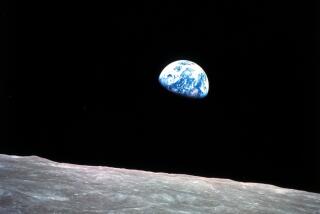Revolution of air travel
- Share via
THE most popular exhibit at the 1939 New York World’s Fair was “Futurama.” Visitors were taken on a simulated flight across America at low altitude, looking down upon intricate models of cities, towns and countryside as they would appear in the imagined future of 1960. Twenty-five million people visited “Futurama”; very few of them had ever traveled in an airplane, much less flown from coast to coast, but for many of them the future was bound up with this new dimension -- the wonder and adventure of movement through the air.
Prior to “Futurama,” nothing heralded that future as much as the moment on May 21, 1927, when Charles Lindbergh’s Spirit of St. Louis swooped out of the night sky to land at Le Bourget airfield outside Paris. His lone flight from New York turned flying into the great adventure of the modern world. As Lindbergh put it, “I have felt the godlike power man derives from his machines; the conquest of distance through mercurial speed; the immortal viewpoint of the higher air.”
In the rich and varied book “The Spectacle of Flight: Aviation and the Western Imagination, 1920-1950,” UCLA history professor Robert Wohl shows how that sense of exhilaration was manifested in the social and cultural history of the age. Millions of people were vicariously drawn to aviation because of its suggestion of freedom, beauty and adventure. Others were attracted by its glimpse of a mystical communion, and still others because it represented the triumph of technology, rationality and the domination of nature.
Indeed, it is no exaggeration to say that our concept of the future, in the sense of improving times to come, was born out of the spectacle of an airplane in flight. No other machine so fully realized our determination to overcome our limitations, defy the power of gravity and obliterate the tyranny of space and time. Boundaries, borders and conventions seemed irrelevant when riding high above the clouds, so that some saw in aviation the promise of a new civilization and a new way of life.
Among the many included in Wohl’s history is the French architect Le Corbusier who announced in 1935, after looking down on the “appalling” confusion of central Paris from an airplane: “New machines, new men!” He argued that European cities should be destroyed and fresh cities built to replace them -- a process begun two years later in a way he did not foresee when the Luftwaffe destroyed Guernica, Spain, from the air.
Le Corbusier was not a fascist, nor was Antoine de Saint-Exupery, the author of “The Little Prince” and of several books in which he developed a philosophy of heroic action based on his experiences as a pilot. Saint-Exupery said that we could realize spiritual values only by pursuing a goal beyond ourselves, even at the risk of death. In the years between the world wars, Europeans yearned for a spiritual meaning they could give to their lives, and in the spectacle of flight many of them found it. But in his exaltation of heroic martyrs, Saint-Exupery was in dangerous company.
It comes as a relief to read in Wohl’s account, which is complemented by rare and evocative illustrations, that Lindbergh’s heroic transatlantic flight was celebrated in America by Mickey Mouse in his 1928 debut cartoon “Plane Crazy.” The mouse tousles his hair in emulation of Lindbergh’s boyish look and takes his girlfriend Minnie for a perilous flight that ends when he crashes and a horseshoe drops on his head.
In fact, as the crowds passed through “Futurama” in 1939 the future envisioned in the exhibit was nearly over. It was not so much that the future arrived with the war and with death falling from the sky, but that the routine and familiarity of commercial air travel when the war was over -- the safety, the predictability, the comfort of it all -- led to the perception that pilots were not spiritual heroes but simply bus drivers.
Again, Lindbergh expressed it well: “In developing aviation, in making it a form of commerce, in replacing the wild freedom of danger with the civilised bonds of safety must we give up this miracle of air? Do the gods retire as commerce and science advance?”
The way we look at the world was transformed during the three decades covered in Wohl’s book, a period in which, with a sense of exhilaration, we moved into the modern age. But why and how did it happen? Working with an abundance of incidents, images and first-person accounts that have been surprisingly little explored until now, Wohl’s achievement has been to recall for us the lives and passions of aviation’s pioneers and to demonstrate how every area of modern culture, from films and literature to architecture and design, owes inspiration to them and their godlike spectacle of flight. *
More to Read
Sign up for The Wild
We’ll help you find the best places to hike, bike and run, as well as the perfect silent spots for meditation and yoga.
You may occasionally receive promotional content from the Los Angeles Times.






